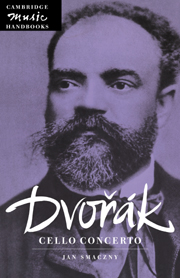Book contents
- Frontmatter
- Contents
- Preface and acknowledgements
- 1 Dvořák and the cello
- 2 Preludes to the Concerto
- 3 The Concerto and Dvořák's ‘American manner’
- 4 ‘Decisions and revisions’: sketch and compositional process
- 5 The score I: forms and melodies
- 6 The score II: interpretations
- 7 Performers and performances
- Notes
- Select bibliography
- Select discography
- Index
4 - ‘Decisions and revisions’: sketch and compositional process
Published online by Cambridge University Press: 02 December 2009
- Frontmatter
- Contents
- Preface and acknowledgements
- 1 Dvořák and the cello
- 2 Preludes to the Concerto
- 3 The Concerto and Dvořák's ‘American manner’
- 4 ‘Decisions and revisions’: sketch and compositional process
- 5 The score I: forms and melodies
- 6 The score II: interpretations
- 7 Performers and performances
- Notes
- Select bibliography
- Select discography
- Index
Summary
Dvořák's sketches are usually illuminating. In the case of the B minor Cello Concerto the remarkable feature that emerges from a comparison of the continuous sketch and the finished score is the extent to which Dvořák refined his initial thoughts; this was less a question of changing the basic inspiration – the essentials of the thematic fibre are all present in the sketch as are many of the formal details – than of adding a deep level of continuity which, especially in the first movement, gives the finished product an organic quality that is often barely apparent in the somewhat episodic continuous sketch.
Although sketching was an important part of the compositional process for Dvořák, he did not, on the whole, go in for working through multiple versions of ideas in the manner of Beethoven. There are occasions when the evolution of a theme involved him in several attempts – ten in the case of the main theme of the finale of the Eighth Symphony – but these are relatively rare. Nor, for much of his career, are there extensive signs of Dvořák collecting melodic raw material as a preliminary to his continuous sketches. During his two American stays (26 September 1892 to 19 May 1894, and 26 October 1894 to 16 April 1895) this practice began to change. Perhaps owing to the pressure that his teaching and administrative duties placed upon his normal composing practices, Dvořák took to notating ideas for works in a series of seven so-called ‘American’ sketchbooks for attention when he had more free time to compose.
- Type
- Chapter
- Information
- Dvorák: Cello Concerto , pp. 29 - 41Publisher: Cambridge University PressPrint publication year: 1999



